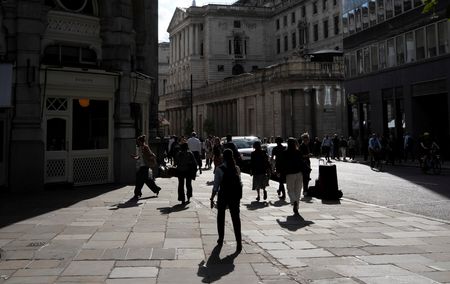By Lawrence White and David Milliken
LONDON (Reuters) -British banks and building societies will be able to issue more potentially risky mortgages, the Bank of England said on Wednesday, as it sought to help the government’s push to boost home ownership.
Individual lenders will now be able to exempt more mortgage borrowers from loan-to-income limits brought in after the 2008 financial crisis, although the sector as a whole will still be subject to a 15% cap on high loan-to-income lending.
Just under 10% of new mortgages exceed 4.5 times a borrower’s income and BoE Governor Andrew Bailey said he would be happy to see that percentage rise.
“If a good part of this was used, this is quite a change,” Bailey said at a press conference to present the central bank’s half-yearly assessment of financial stability risks.
The change could lead to up to 36,000 new higher loan-to-income mortgages a year, BoE Deputy Governor Sam Woods said.
British lenders approved 755,000 mortgages for house purchases last year, according to BoE data. Property sales have slowed slightly since the end in April of a temporary tax break, but a slow pace of new construction and rising wages are expected to keep upward pressure on prices.
The BoE said the change in rules should allow more first-time buyers to get a mortgage, although it added that lenders’ deposit requirements were a bigger barrier for most borrowers.
LOWER DEPOSITS
Britain’s governing Labour Party said in its 2024 election campaign that it intends to make permanent a government insurance scheme that encourages lenders to accept lower deposits, alongside a pledge to build 1.5 million more homes.
The loosening of the cap on lending to riskier borrowers comes after a call by the government for regulators to look for ways to encourage economic growth, without risking the stability of the financial system.
The loan-to-income limit was introduced in 2014 as part of measures to discourage excessively risky mortgage lending by banks which contributed to the 2008 global financial crisis.
Lenders have since become better capitalised and introduced more stringent checks on borrowers.
The BoE said individual banks’ general unwillingness to risk a breach of the 15% cap on high loan-to-income loans meant that the sector as a whole had stayed well below the threshold.
Banks’ aggregate share of high loan-to-income lending hit 9.7% in the first quarter, the BoE said. Allowing some individual lenders to go above that threshold would likely only lead to an overall share of such riskier lending hitting 11% by the end of 2025, the central bank forecast.
The BoE will also refresh its assessment of banks’ overall capital requirements and update the market on that at its next financial stability report in December, it said, the first such review in five years.
However, the BoE noted that it currently judged the overall level of capital in the system to be “broadly appropriate”.
Deputy Governor Sarah Breeden said she would welcome broader international discussion of what aspects of post-2008 capital rules had proved most valuable, in the light of experience in the COVID-19 pandemic.
The BoE added that the review would not stop it publishing revised rules for smaller banks in the coming weeks.
(Reporting by Lawrence White and David Milliken; Editing by Sharon Singletondavid.milliken@thomsonreuters.com; +44 20 7513 4034)










